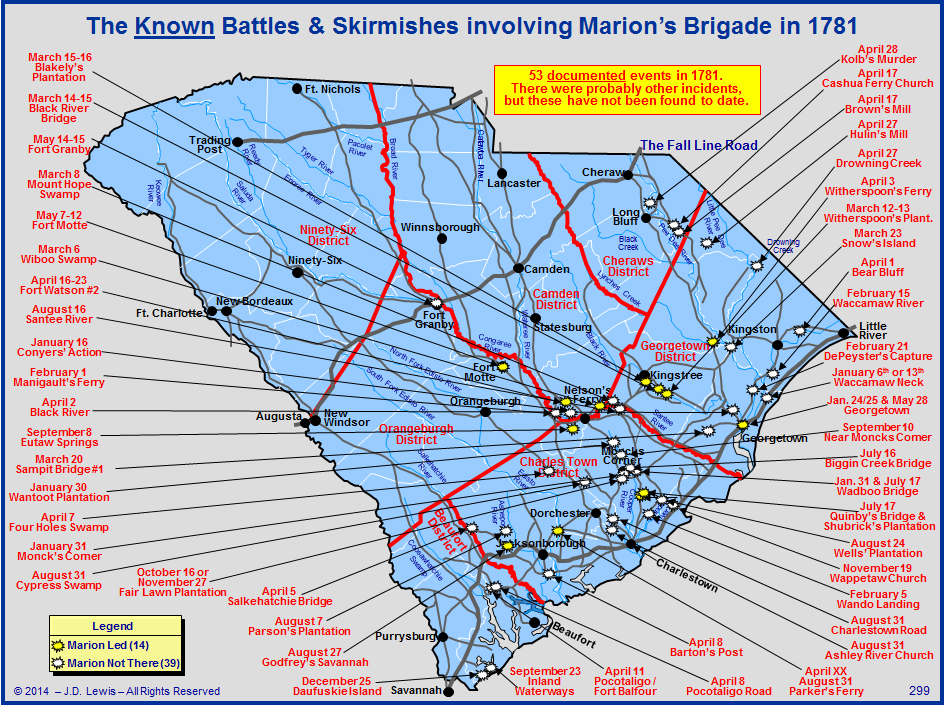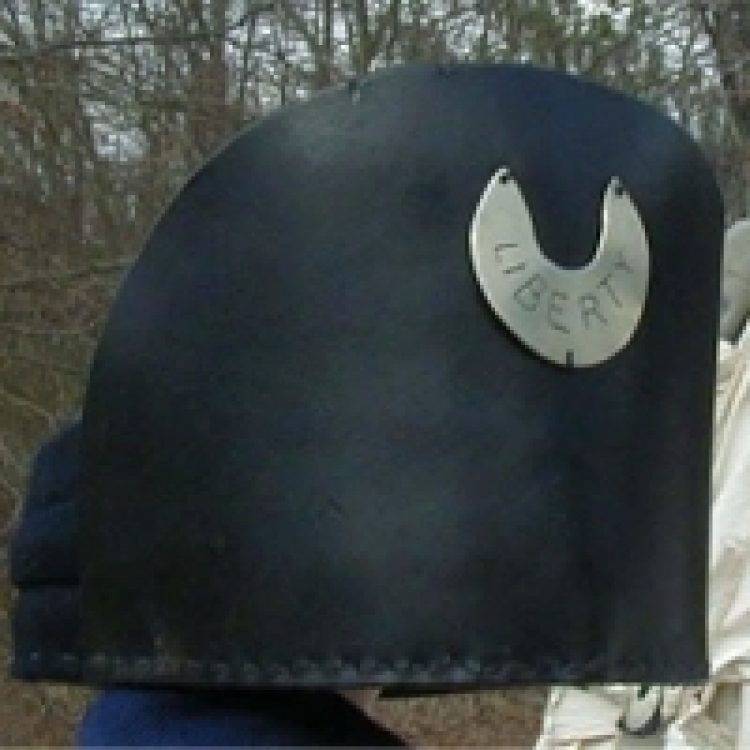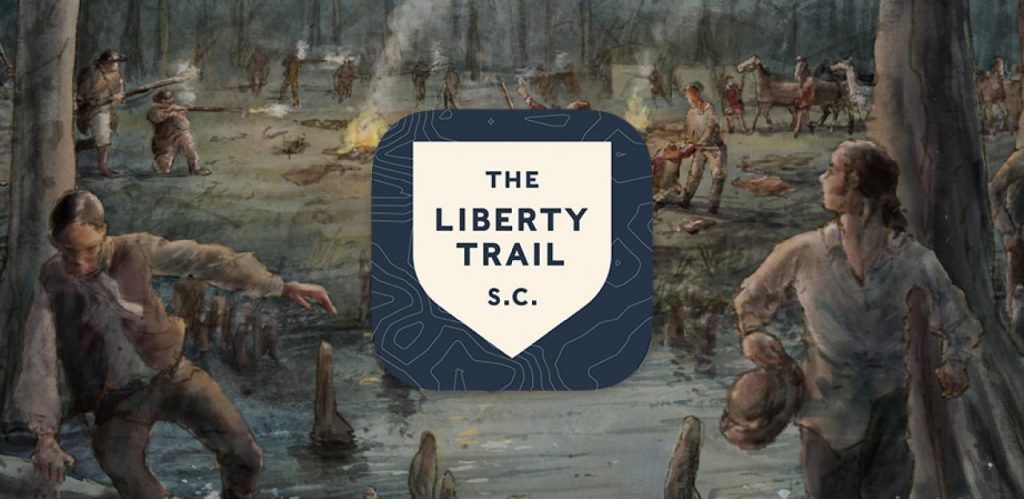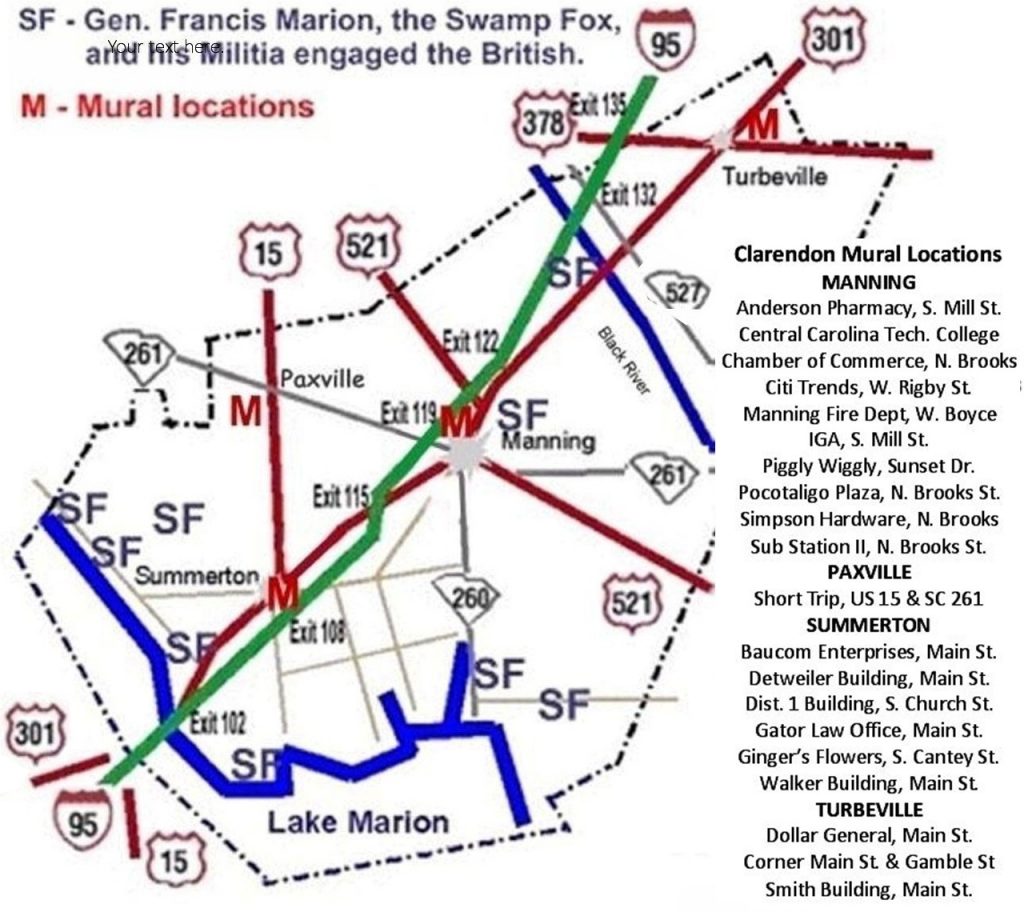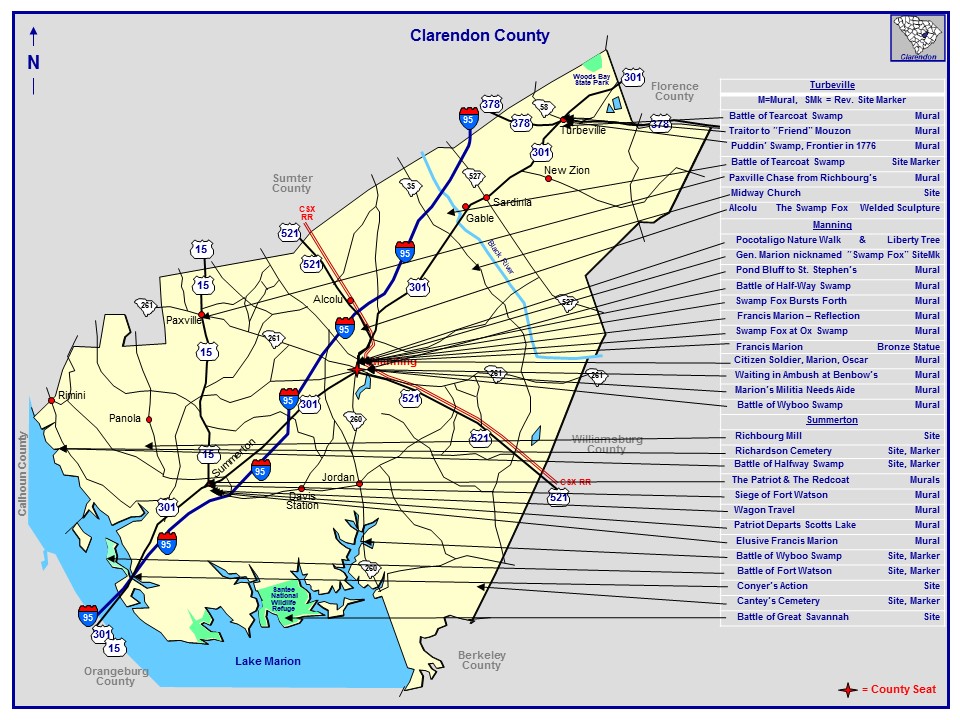Marion Data, Rev War, Southern Campaigns
About General Francis Marion, The "Swamp Fox"
Links you can use below:
For South Carolina Revolutionary War battles, maps, and command structure, JD Lewis has done extensive work: Carolana.com the Revolutionary War in South Carolina.
JD’s presentation at Francis Marion Symposium, Evolution of Marion’s Brigade and Evolution_of_Marion’s_Brigade_1780_to_1782_JDL.pdf
JD’s Clarendon County map and engagements.
Search the Rev. War Pension records on-line
Southern Campaigns of the American Revolution (SCAR)
Charles Baxley and Dr. Steve Smith are on Walter Edgar’s Journal’s broadcast, discussing the Battle at Parker’s Ferry. Listen online anytime.
South Carolina Liberty Trail vid
American Battleground Preservation Trust, Southern Campaigns vid (Of course, there’re more events and sites than mentioned)
Marion life events and research bibliography (linked), Choke Points below.
For fun, Swamp Fox song on Facts & Trivia page.
Below 1. Significant Rev. War Events, JD Lewis’ Francis Marion Timeline After the Fall of Charleston, 1780-1782.
2. Significant Rev. War Events for 1780-1782 by Scott Aiken to compare Marion’s and other events in the Southern Department.
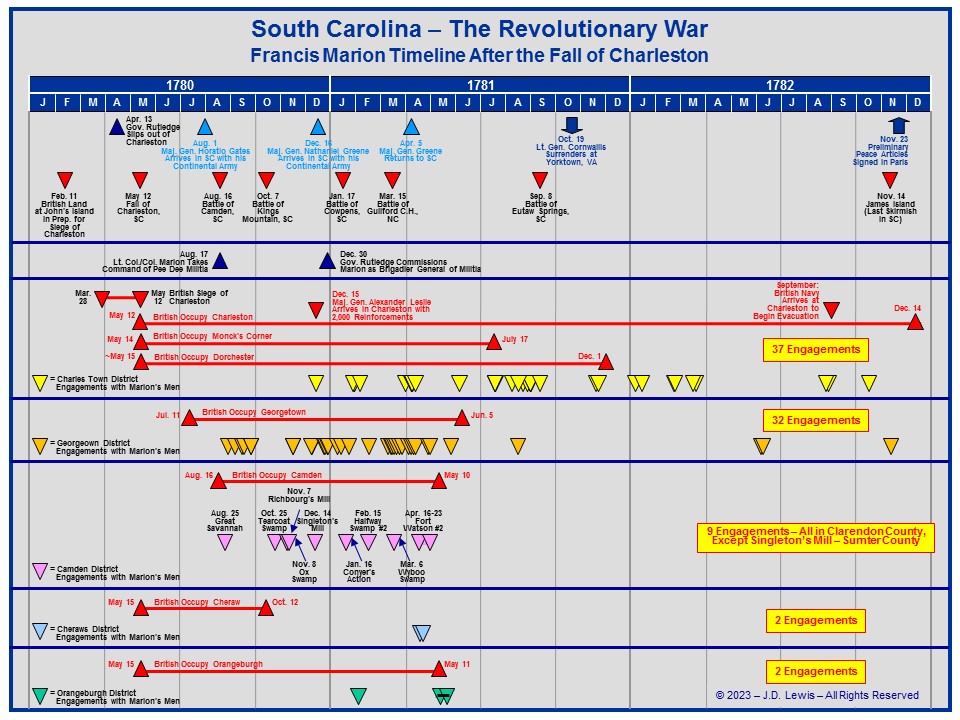
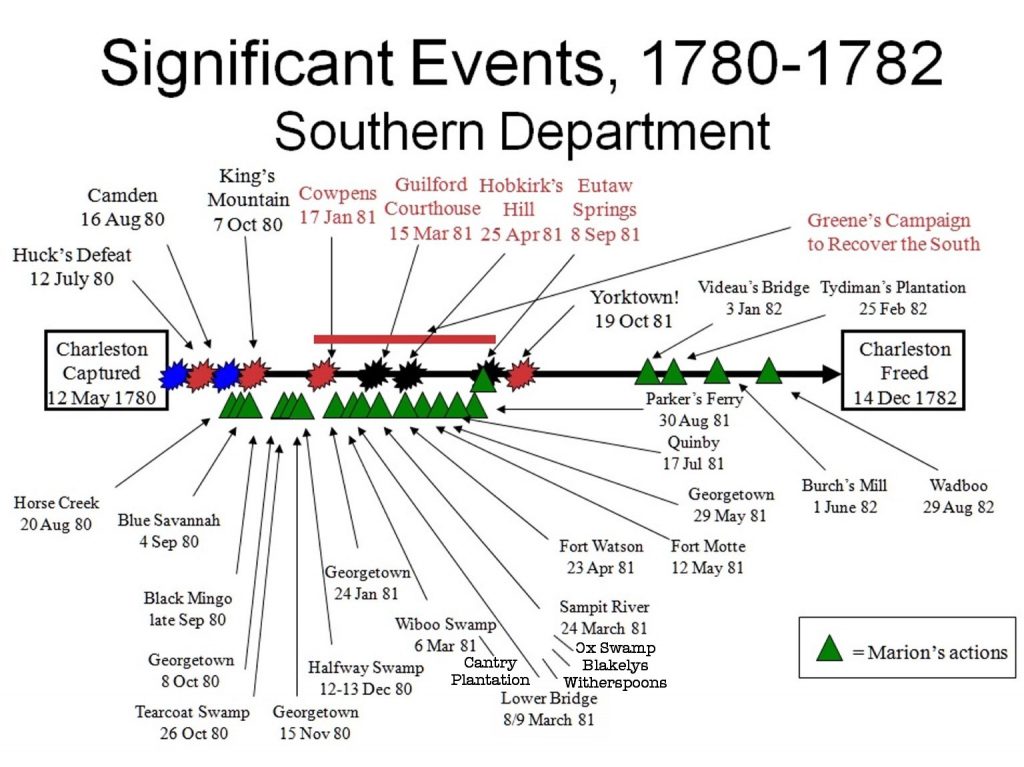
Our artist friend, with a passion for General Francis Marion and over 35 years of research on Marion, paints this depiction of Marion.
Reflections on General Francis Marion at General Francis Marion Memorial Day 2011 by Karen MacNutt.
In the darkest hour of the American Revolution, Francis Marion stepped forward when others were giving up. With little but his passion for liberty and strength of intellect, he organized a force of patriots that frustrated British attempts to invade Virginia thereby setting the stage for the British defeat at Yorktown. Loved by his followers, respected by his enemies, he is one of the foremost heroes of our War for Independence.
- Historic Marker for Marion’s tomb
- Eutaw Springs participants.
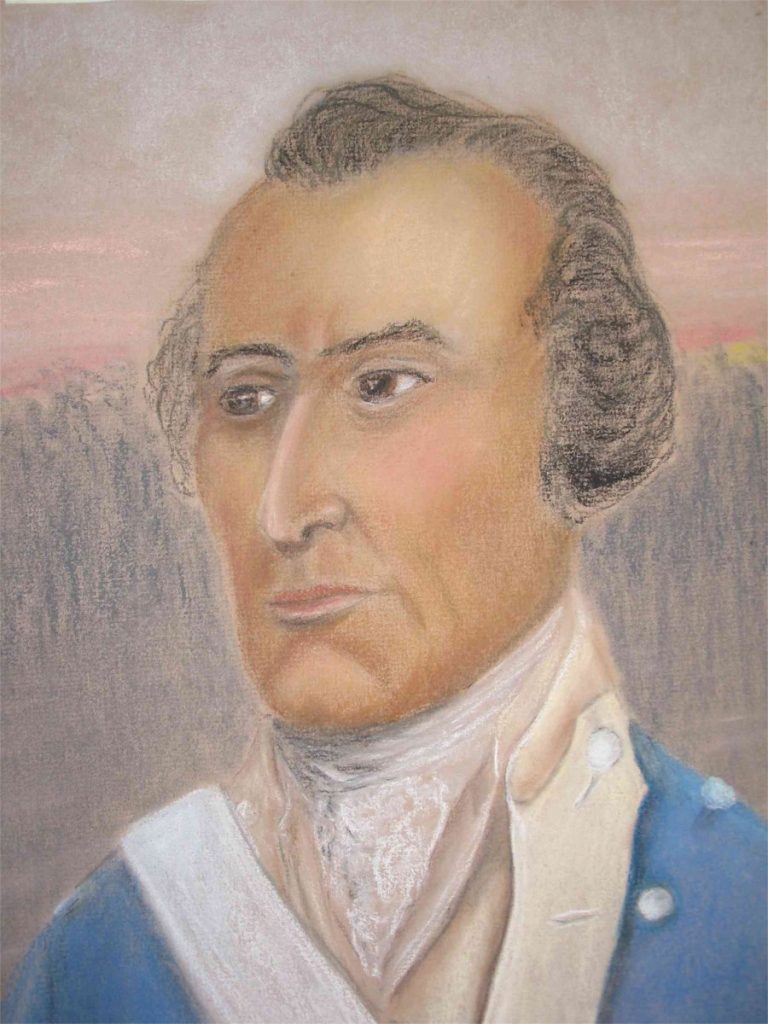
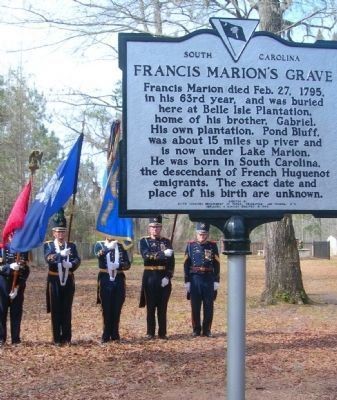
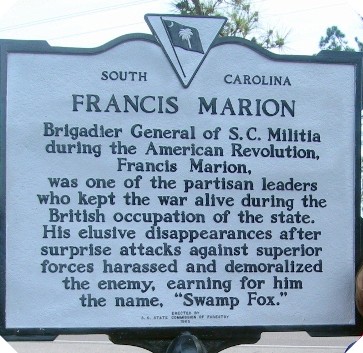

Recruiting Militia - Ride to North Carolina September 8 - 24, 1780
A Horse For Francis Marion
September 28-29, 1780
Marion, back in SC, attacked Col. Ball at Black Mingo, Mouzon was wounded. Francis Marion and his men needed horses for the way they fought and his guerrilla tactics throughout this Santee and Black River area. It was important for Marion to have a strong horse. Marion found exactly what he needed.
At Black Mingo Creek, in Williamsburg County, just east of Kingstree. September 28-29, 1780 Marion militiamen attacked Col John Cummins Ball, a Tory, and his men at Black Mingo. He captured Col. Ball’s horse and rode him the rest of the war and long after and called him “Ball”.
For map and personnel involved in engagement, see JD Lewis slide 46 or this event.
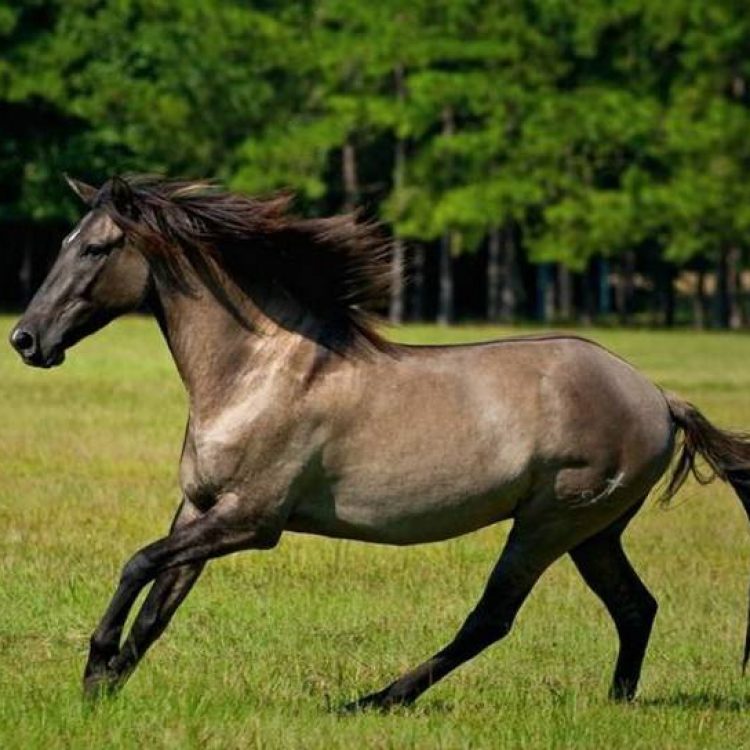

Pursuit to Ox Swamp
Wednesday, November 8, 1780
Directions: I-95 Exit 119 – go east on SC 261. I-95 Exit 122 – go east on US 521. The road crosses Ox Swamp just east of Manning.
Upon learning from a Tory spy that General Marion slipped back east of Jack’s Creek, Tarleton gave chase with his Green Dragoons. Marion, staying just ahead of the dragoons, and fighting a series of delaying tactics with his rear guard, rode to the head of Jack’s Creek, Sammy Swamp and then down the Pocotaligo and slipped away into Ox Swamp. Here Tarleton gave up the chase and said “as for the old fox, the devil himself could not catch him.” Thus, General Francis Marion became known as the “Swamp Fox”. Marion and his men continued east to Benbow’s Ferry on the Black River where he had established the ambush for the British.
- Find Ox Swamp and the Pocotaligo: 33° 41′ 32″ N 80° 12′ 03″ W for this event.
- SC ETV “Chasing the Swamp Fox“ on-line.
On November 8, 1780, after a seven-hour, 26 mile chase, of Col. Francis Marion by Lt. Col. Banastre Tarleton, he, Tarleton, gave up at Ox Swamp, just a few miles short of Benbow’s. Col. Francis Marion and his band of Patriots remained at Benbow’s Ferry on the Black River where he had prepared his own ambush for Lt. Col. Tarleton – however, Tarleton never came, but instead began burning homes in the vicinity, including the barn of Mrs. Richardson and all her livestock.
- Benbow’s Ferry Site
- Directions: East of Manning on SC 261. Left, north, onto S-55 at Martine Crossroads.
- The ferry was located just east of where the bridge crosses the Black River.
- Marion positioned his force in an ambush for Tarleton along the approach to the ferry.
- Mural in Manning of Ambush at Benbow’s Ferry, West facing wall of Piggly Wiggly, sunset Dr., Manning, SC.
Ambush Set at Benbow's
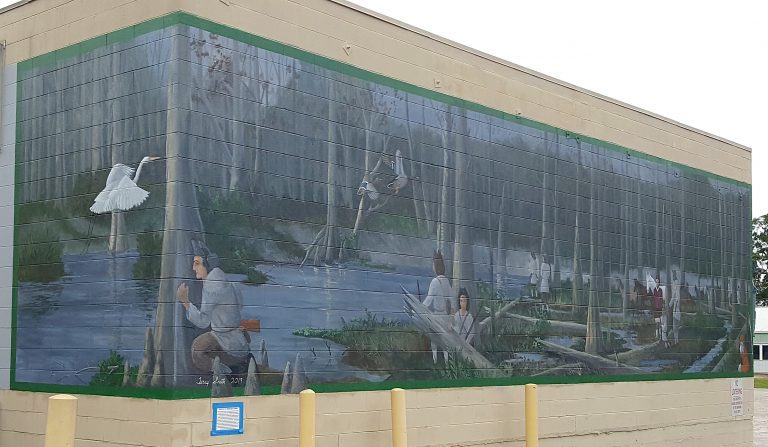
Time Travel from November 8, 1780 to April 23, 1781 in Clarendon County, SC
Siege of Fort Watson
Monday to Monday, April 16-23, 1781
Directions: I-95 Exit 102, South of Summerton. Historic US 301 north, turn west onto Fort Watson Road (S-803). Markers and the Indian Mound, site of Fort Watson, are at the end of the road.
Colonel Harry Lee and Lee’s Legion from Virginia had joined General Marion and Marion’s Brigade on the Black River on April 14, 1781. Marion and Lee elected to capture the British fort, built in December 1780, Fort Watson on the Santee and beside Scott’s Lake, to secure the area and to get badly needed supplies. They laid siege to the fort. The cannon never arrived. “Col. Maham contrived to raise a tower of logs, so high that it overtopped the fort.” The tower was erected over night after collecting saplings for several days. The use of the tower by the McCottry riflemen at sunrise led to the quick surrender of Fort Watson by Lt. James McKay on the morning of April 23, 1781 and was the final Battle of Fort Watson.
- Fort Watson mural – the North facing wall of Summerton Hardware, Main Street.
- Historic marker at Santee Indian Mound
- Former Crypt cover, Marion stone
- New free App: Fort Watson AR
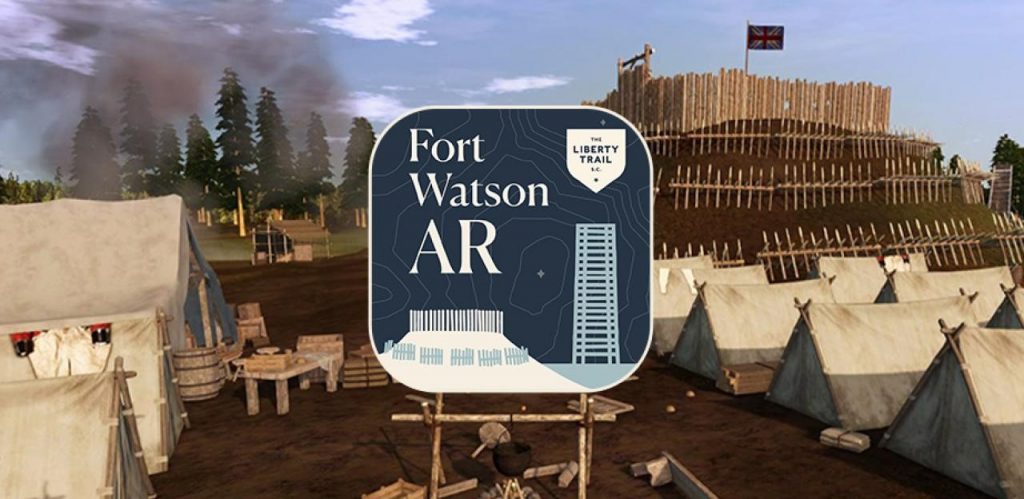
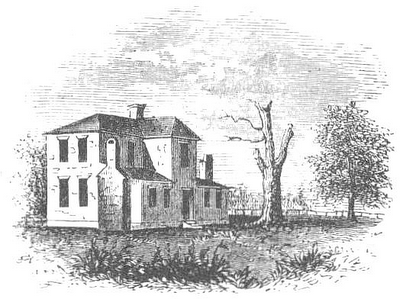
Fort Motte
May 8, 1781 Marion and Lee arrived at Fort Motte.
The Rebecca Motte home was located on the south side of the Congaree River just west of the Congaree & Wateree joining to form the Santee River.
Marion’s militia along with Lee’s Legion, laid siege to Fort Motte May 8, 1781. They dug trenches to get closer to the home the British had fortified. On May 12 the Patriots asked and Mrs. Motte agreed, they would set fire to the house. A bow and arrows or pitch balls were used to set the wood shingles on the roof on fire. As the roof started to burn the British surrendered and both groups worked to put it out. That evening Mrs. Motte had dinner cooked for the officers from both sides.
While eating, Gen. Marion was told some of Lee’s men were hanging the British prisoners. Marion immediately stopped this action and protected the prisoners.
May 12, 1781 Patriots, led by Francis Marion and Henry Lee, captured the British post known as Fort Motte (at Rebecca Motte’s Mount Joseph plantation, sketch from BJ Lossing in 1840s).
The British had used Fort Motte as another of the outposts to guard Charlestown.
Statue
General Francis Marion in St. Mark’s Parish, now Clarendon County, is in the Continental uniform of his 2nd SC Regiment after he occupied Georgetown, June 6, 1781.
Marion statue is sponsored by the Swamp Fox Murals Trial Society.
Come to Manning to see Francis Marion in the Clarendon County Chamber of Commerce window, 19 N. Brooks Street.
These Swamp Fox engagements were after Charlestown fell and the British occupied it starting on May 12, 1780. Marion had escaped capture and was the only senior Regimental or Continental Officer free to lead the local militia. Find this statue: 33.696° N 80.211° W
Francis Marion and the Sweet Potato Story
Francis Marion was in his camp near Snow Island on the Pee Dee River with his Militiamen. A British officer visited with Marion under a flag of truce to negotiate an exchange of prisoners. Marion offered him a meal consisting of sweet potatoes cooked in the ashes of the campfire and water to drink. The British officer returned to Charlestown and refused to fight against an enemy (the Patriots) as dedicated as Francis Marion, “who ate roots cooked in a fire and drank nothing but water from the swamp.”
There are about 12 different paintings that depict this event. All these paintings or etchings were done after General Marion died. The Sweet Potato story from the US Senate.
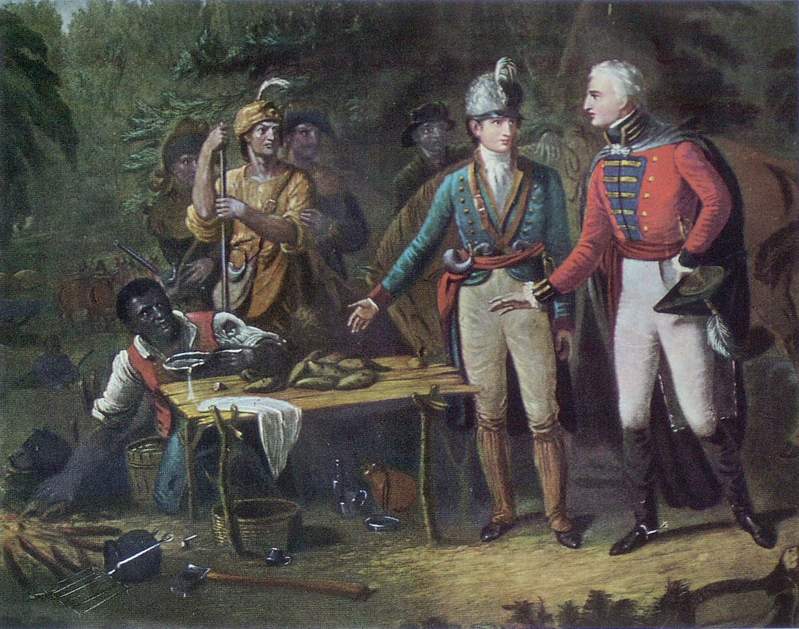
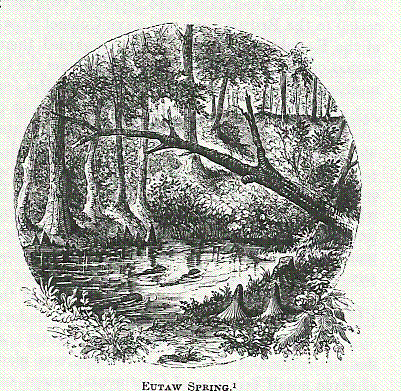
Eutaw Springs Battle
Saturday, September 8, 1781
Directions: I-95 Exit 98 east on SC 6 to Eutaw Springs.
The Battle of Eutaw Springs was the last large battle fought in the campaign to end British occupation of the Carolinas and Georgia. On September 8, 1781, Major General Nathanael Greene’s Continental Army accompanied by militia (Marion and his Militia led the 4 militia front line) attacked the British Army under the command of Lt. Col. Alexander Stewart at Eutaw Springs. Over 4000 men fought for more than 4 hours in the stifling heat. It was the bloodiest battle of the Revolutionary War and soldiers reported wading through puddles of blood on the field and men were standing, dead, impaled on each other’s bayonets. When the carnage was over, the British evacuated the area and moved to Chalestown Neck. Five weeks later, when the British surrendered at Yorktown, they had no claim to the Carolinas and Georgia.
- The Battle of Eutaw Springs had ended British control. (from Christine Swager: “The Valiant Died”). Find this battlefield: 33° 24′ 26″ N 80° 17′ 55″ W
- Francis Marion’s home was on the banks of the Santee River, between Eutaw Springs and Belle Isle, called Pond Bluff; picture from 1930s and the 3rd version called Pond Bluff.
- Francis Marion’s Tomb is a SC State Site near Pineville: 33° 27′ 14″ N 80° 05′ 14″ W
- Karen’s presentation at Marion’s grave
British evacuation of Charlestown, SC
December 14, 1782
Victory Day: the successful conclusion of the Revolutionary War marked by the end of hostilities between the American Army and the surrounded British forces occupying Charlestown; Celebrated at Marion Square. (Marion didn’t come to Charleston for this in 1782, his men/Militia were not invited, so he told them he was not coming, probably using the threat that some had smallpox.)
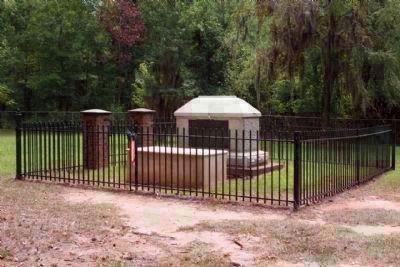

Find History!
Revolutionary War Locations in Clarendon County Area
| # On Clarendon Map | Date | Location |
| 1 | 1780-08-17 | Nelson’s Ferry |
| 2 | 1780-08-25 | Great Savannah |
| 7 | 1780-10-25 | Tearcoat |
| 8a | 1780-11-08 | Jack’s Creek |
| 8b | 1780-11-08 | Ox Swamp |
| 13 | 1780-12-12 | Halfway Swamp |
| 14 | 1780-12-13 | Singleton’s Mill |
| 16 | 1780-12-17 | Santee River Rd |
| 22 | 1781-03-06 | Wiboo Swamp |
| 23 | 1781-03-06 | Cantey Plantation |
| 24 | 1781-03-13 | Mt. Hope Swamp |
| 37 | 1781-04-15 | Fort Watson |
| 41 | 1781-08-16 | Santee River |
| 44 | 1781-09-08 | Eutaw Springs |
| 54 | Richardson Cemetery | |
| 55 | 1795-02-27 | Marion’s Tomb |
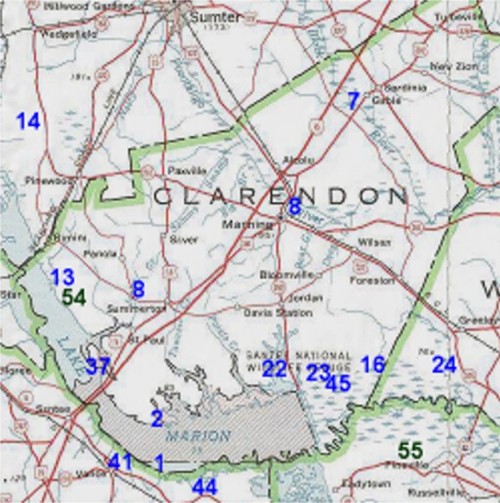
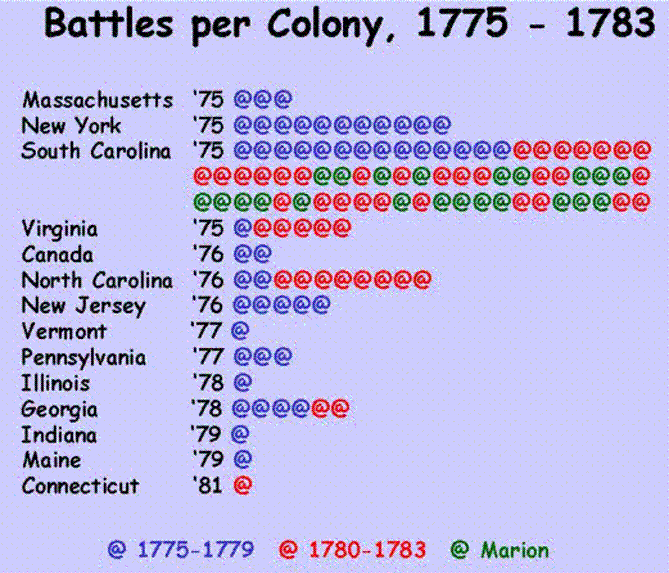
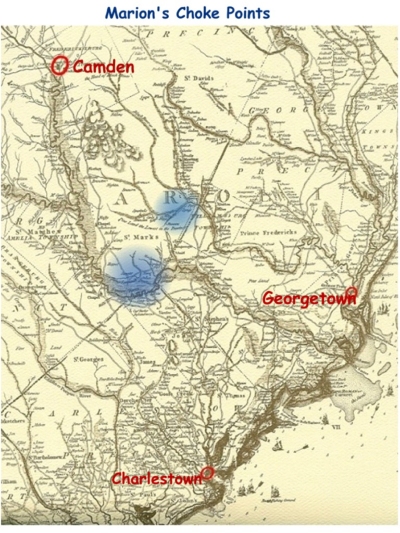
Choke points on the Santee River and Black River where Marion cut the British supply lines.

